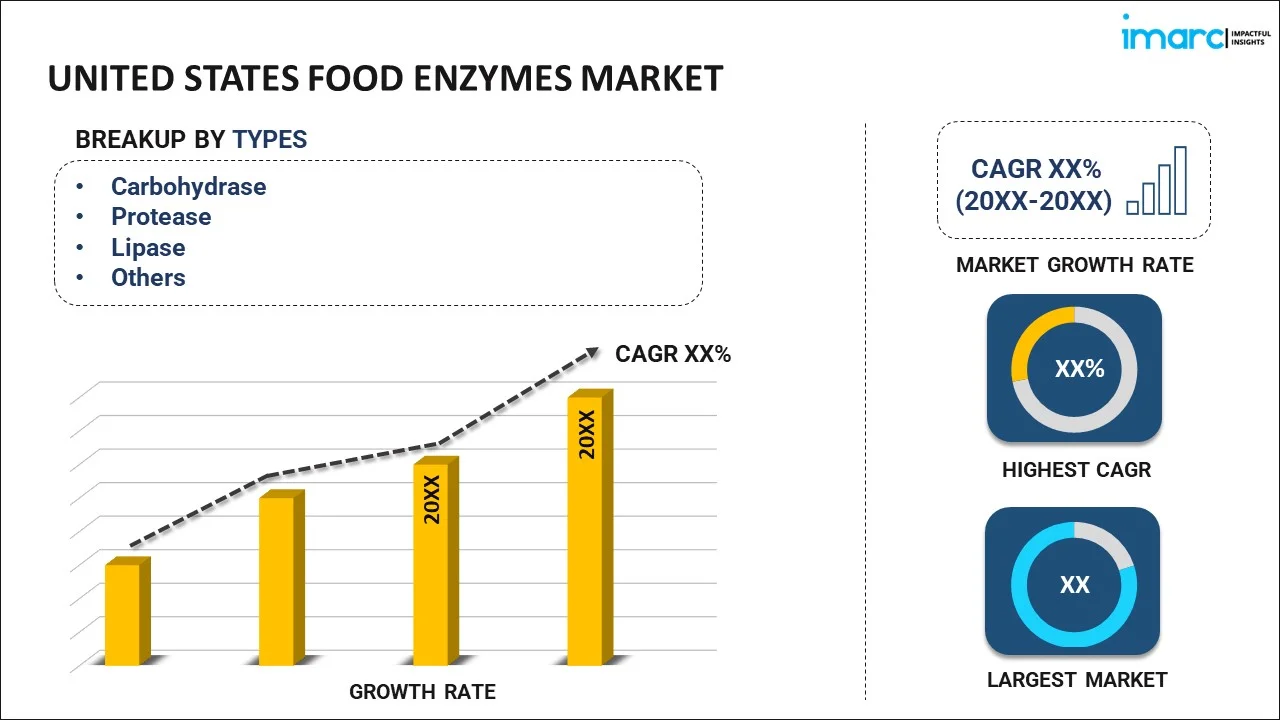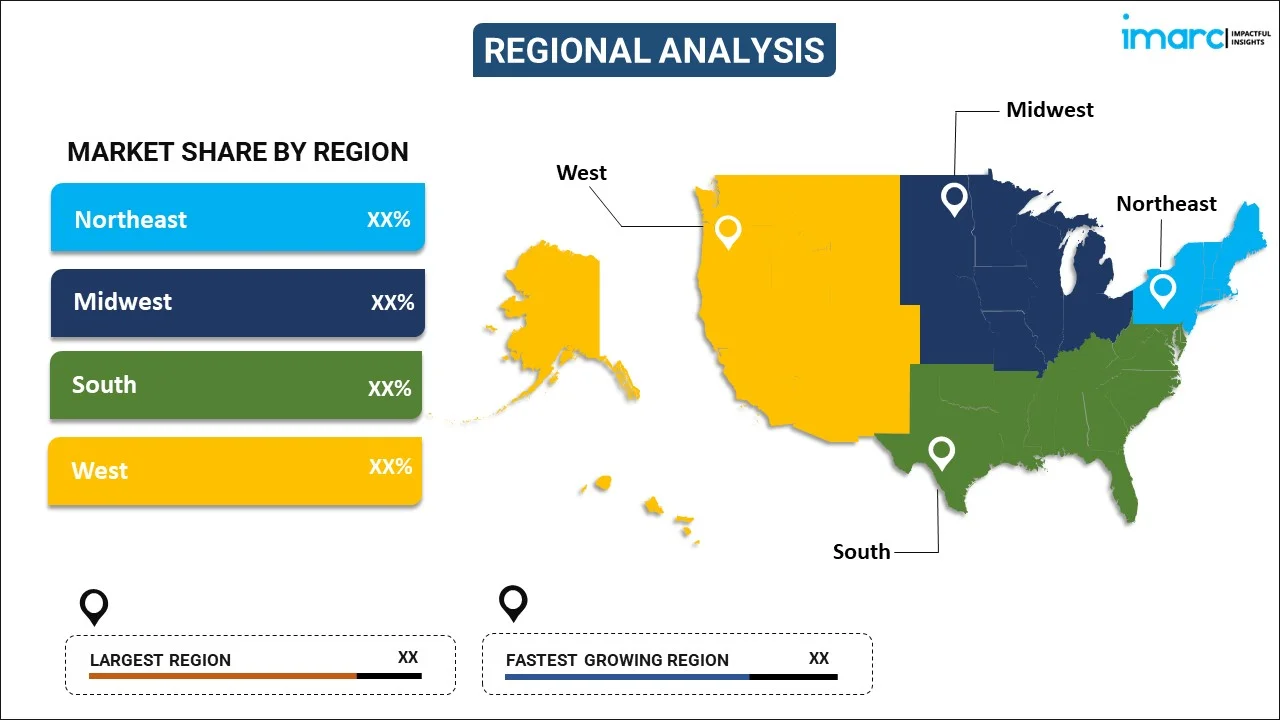
United States Food Enzymes Market Report by Type (Carbohydrase, Protease, Lipase, and Others), Source (Microorganisms, Bacteria, Fungi, Plants, Animals), Formulation (Powder, Liquid, and Others), Application (Beverages, Processed Foods, Dairy Products, Bakery Products, Confectionery Products, and Others), and Region 2026-2034
United States Food Enzymes Market Size, Share & Analysis:
The United States food enzymes market size reached USD 592.9 Million in 2025. Looking forward, IMARC Group expects the market to reach USD 877.6 Million by 2034, exhibiting a growth rate (CAGR) of 4.45% during 2026-2034.
United States Food Enzymes Market Insights:
- Key Market Drivers: The increasing demand for clean-label and functional foods, as well as the spread of plant-based and gluten-free diets, is fueling the market through the promotion of the use of natural processing aids to enhance product quality, propelling United States food enzymes market share.
- Key Market Trends: Enzyme uses in plant-based food processing and functional drinks are increasing at a fast pace, showing changing consumer behaviors towards healthy-oriented, sustainable, and digestible offerings. This demand is transforming innovation strategies in the United States food enzymes market scenario.
- Competitive Landscape: The competitive dynamics are driven by ongoing innovation in enzyme formulations, with market leaders emphasizing product differentiation for bakery, dairy, and nutraceuticals. Strategic alliances and R&D efforts also characterize the dynamic market landscape in the United States.
- Challenges and Opportunities: Whereas regulatory intricacies and formulation limitations are formidable challenges, growing demand for personal nutrition and plant alternatives is a powerful growth opportunity that renders the United States food enzymes market dynamic and progressively diversified in use.
|
Report Attribute
|
Key Statistics
|
|---|---|
|
Base Year
|
2025
|
|
Forecast Years
|
2026-2034
|
|
Historical Years
|
2020-2025
|
|
Market Size in 2025
|
USD 592.9 Million |
|
Market Forecast in 2034
|
USD 877.6 Million |
| Market Growth Rate 2026-2034 | 4.45% |
Access the full market insights report Request Sample
Food enzymes are biocatalysts that initiate chemical reactions to convert complex carbohydrates and fats into a digestible form. The primary sources of these enzymes include plants, animal tissues and microorganisms. Protease, lipase, amylase, pectinase, rennet and cellulase are some of the enzymes widely used in the food and beverage industry. They are primarily used in the production of bakery products, processing of cheese and starch, meat tenderizing and manufacturing of fruit juices.
Significant growth in the food and beverage industry in the United States is one of the key factors creating a positive outlook for the market. In line with this, cafés, hotels and quick serving restaurants (QSRs) extensively use food enzymes to impart innovative and exotic flavors to the dishes. Food and beverage manufacturers across the country also use these enzymes to improve the quality and increase the products' shelf-life. Moreover, changing lifestyles and increasing health consciousness among consumers is further contributing to the market growth. This has resulted in the rising demand for functional foods, which are fortified with natural food enzymes. Additionally, the utilization of innovative, genetically engineered food enzymes for industrial food manufacturing is acting as another major growth-inducing factor. These enzymes are also used by meat vendors to process and tenderize red meat, poultry and seafood products.
United States Food Enzymes Market Trends:
Clean Label Movement Driving Enzyme Adoption in Processed Foods
According to United States food enzymes market analysis, the increased demand for clean-label products is driving significantly the adoption of food enzymes in processed food segments. Consumers are increasingly demanding transparency in ingredients, with food manufacturers being compelled to cut down on synthetic additives and chemical processing aids. Under such circumstances, enzymes from natural origins are a viable alternative that can enhance texture, shelf-life, and nutritional value without sacrificing labeling standards. Enzymes are highly being used in baking, dairy, and meat processing to provide functional benefits while supporting clean-label claims. This trend is driving the increasing market share, as enzymes are both safe and natural. The overall United States food enzymes market trends indicate a high correlation with health-conscious consumer behavior and sustainability guidelines. While regulatory systems are perpetuating enzyme applications, their compatibility with clean labels is also expected to continue being a key driver of long-term market growth.
Growing Demand for Functional Foods and Soft Drinks
Demand for functional foods and beverages (F&B) in the United States is propelling the widespread use of food enzymes to increase bioavailability, digestibility, and nutritional content. As consumers become more interested in preventative health, enzymes are also being utilized to enhance products like protein beverages, plant-based drinks, and dairy substitutes. These enzymes help break down complex molecules, enhancing absorption and providing targeted health benefits like gut health or lactose reduction. This functional benefit is helping them fulfill the changing dietary needs of health-focused Americans. The United States food enzymes market demands are being influenced by this trend, as enzymes enable manufacturers to provide differentiated products with measurable health effects. This trend, in addition to sustaining market expansion, also results in increased product innovation and market segmentation. With increased formulation strengths, enzymes are becoming central to the future of functional nutrition in the market analysis.
Enzyme Incorporation in Plant-Based Food Processing
The uptick in plant-based eating throughout the United States has opened up new avenues for enzyme use, most notably in the flavor, texture, and digestibility of alternative proteins and meat alternatives. Enzymes are being used to degrade tough plant constituents, mitigate bitterness, and simulate animal-derived product features while not sacrificing plant integrity. As per the sources, in September 2023, Novozymes introduced Vertera ProBite, a biological enzyme solution with MTGase to enhance texture in plant-based meat, which increases mouthfeel and facilitates production with no label claims. Moreover, as consumer demand for ethical and sustainable eating continues to grow, enzymes give manufacturers an economical solution to tackle formulation issues in plant-based food. This innovation is strengthening the positive trajectory of the market trends, as enzymes help facilitate product development alignment with consumer ethics. The entry of enzymatic processing technologies has fortified the United States food enzymes market share in the alternative protein market, which continues to be among the fastest-growing segments. Enzyme solutions thus emerge as catalysts of product quality and efficacy, highlighting their growing significance in market analysis.
Key Market Segmentation:
IMARC Group provides an analysis of the key trends in each sub-segment of the United States food enzymes market report, along with forecasts at the country and regional level from 2026-2034. Our report has categorized the market based on type, source, formulation and application.
Breakup by Type:

To get detailed segment analysis of this market Request Sample
- Carbohydrase
- Amylase
- Cellulase
- Lactase
- Pectinase
- Others
- Protease
- Lipase
- Others
Breakup by Source:
- Microorganisms
- Bacteria
- Fungi
- Plants
- Animals
Breakup by Formulation:
- Powder
- Liquid
- Others
Breakup by Application:
- Beverages
- Processed Foods
- Dairy Products
- Bakery Products
- Confectionery Products
- Others
Breakup by Region:

To get detailed regional analysis of this market Request Sample
- Northeast
- Midwest
- South
- West
Competitive Landscape:
The competitive landscape of the industry has also been examined along with the profiles of the key players.
Latest News and Developments:
- In May 2024, Amano Enzyme USA started to expand its Elgin, Illinois plant with a 29,827 sq. ft. manufacturing, warehousing, and office space addition. The location serves North, Central, and South American markets, supporting the company's strategy for growth and long-term commitment to the provision of high-quality specialty enzyme solutions for food processing.
- In June 2023, dsm-firmenich introduced Maxilact®Next, a high-purity lactase enzyme that lowers hydrolysis time by 25%, enhancing efficiency in lactose-free dairy manufacturing. The innovation enables higher output, optimized raw material utilization, and uniform taste, matching increasing global demand for lactose-free products without extensive production investment.
Report Coverage:
| Report Features | Details |
|---|---|
| Base Year of the Analysis | 2025 |
| Historical Period | 2020-2025 |
| Forecast Period | 2026-2034 |
| Units | Million USD |
| Segment Coverage | Type, Source, Formulation, Application, Region |
| Region Covered | Northeast, Midwest, South, West |
| Customization Scope | 10% Free Customization |
| Post-Sale Analyst Support | 10-12 Weeks |
| Delivery Format | PDF and Excel through Email (We can also provide the editable version of the report in PPT/Word format on special request) |
Key Questions Answered in This Report
The food enzymes market in the United States was valued at USD 592.9 Million in 2025.
The United States food enzymes market is projected to exhibit a (CAGR) of 4.45% during 2026-2034, reaching a value of USD 877.6 Million by 2034.
The market is driven by mounting demand for convenience and processed foods, growing consumer interest in digestive health, and the trend towards clean-label and natural products. Technological advancements in biotechnology and enzyme engineering are also facilitating more specific applications, enhancing food quality, shelf life, and efficiency of production in different sectors of food and beverages (F&B).
Need more help?
- Speak to our experienced analysts for insights on the current market scenarios.
- Include additional segments and countries to customize the report as per your requirement.
- Gain an unparalleled competitive advantage in your domain by understanding how to utilize the report and positively impacting your operations and revenue.
- For further assistance, please connect with our analysts.
 Request Customization
Request Customization
 Speak to an Analyst
Speak to an Analyst
 Request Brochure
Request Brochure
 Inquire Before Buying
Inquire Before Buying




.webp)




.webp)












